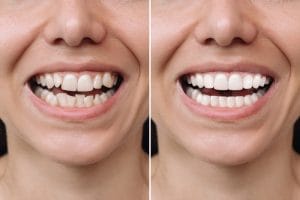Signs of a Misaligned Bite: How to Recognize and Address Bite Issues
 Understanding Misaligned Bites: Basics and Importance
Understanding Misaligned Bites: Basics and Importance
A misaligned bite, known as malocclusion, occurs when upper and lower teeth do not come together properly. This can manifest as overbites, underbites, crossbites, or open bites. Orthodontic treatment with braces or clear aligners is crucial for correcting malocclusion by gradually realigning the teeth for improved appearance and functionality.
Defining Misaligned Bite and Its Types
Misaligned bites include overbite, underbite, crossbite, and open bite. Understanding these types is crucial for effective treatment. Consult an orthodontist for diagnosis and a personalized treatment plan.
Why Correcting a Misaligned Bite is Crucial for Oral Health
Keeping your bite healthy is crucial for overall oral health. An off-bite can lead to difficulties in chewing, impacting oral hygiene. Misaligned teeth can trap food, causing plaque buildup, decay, and gum disease.
Furthermore, a bad bite can result in teeth wear and jaw issues like pain and headaches. Orthodontic treatment can enhance your smile and address these oral health concerns by aligning teeth and jaws, improving biting function and preventing dental problems in the long run.
Identifying Common Symptoms and Visible Signs
Recognizing signs of a misaligned bite is key to getting the right treatment. Look for crooked teeth, uneven wear, chewing difficulties, and speech problems. Jaw pain, headaches, or jaw clicking are also indicators that require professional evaluation.
Recognizing Uneven Wear on Teeth and Misalignment Issues
Uneven wear on teeth indicates a misaligned bite. It affects your smile’s appearance and dental health, leading to potential damage or decay. Seek orthodontic assessment if you notice uneven tooth wear, to prevent further issues and improve chewing efficiency.
The Impact of Misaligned Bite on Speech and Breathing
A misaligned bite can impact speech and breathing. Incorrect teeth and jaw alignment may cause speech issues like lisping or difficulty pronouncing words. It can also lead to breathing problems, especially when breathing through the mouth, potentially causing long-term issues like dry mouth, bad breath, and sleep apnea. Consult an orthodontist if you experience these problems.
Exploring the Consequences of Ignoring Bite Issues
Ignoring a bad bite can lead to serious dental issues beyond crooked teeth, such as tooth decay, gum disease, and even tooth loss. Regular visits to dentists or orthodontists are crucial for maintaining oral health and preventing these complications from worsening.
How a Misaligned Bite Affects Overall Oral Health
A misaligned bite can lead to bacterial growth, oral diseases, plaque buildup, gingivitis, and potentially periodontitis. Additionally, it can result in stress on teeth and jaw joints, leading to jaw pain, headaches, and TMJ disorders. Timely orthodontic treatment can prevent these issues and maintain your oral health.
The Relationship Between Bite Problems and TMJ Disorders
The TMJ, a hinge connecting your jawbone to your skull, allows movement for talking, chewing, and yawning. Misalignment can lead to TMJ disorders with symptoms like jaw pain, clicking sounds, headaches, and more.
Available Treatment Options in Sarasota, Florida
If you require orthodontic treatment in Sarasota, Florida, various options are available to address bite issues. Orthodontists specialize in diagnosing and treating dental and facial problems by tailoring treatment plans to individual needs. Choose between traditional braces or clear aligners based on your lifestyle and preferences. These appliances gradually shift teeth into correct positions, enhancing bite function, improving smile aesthetics, and promoting long-term oral health.
Braces and Clear Aligners: Traditional vs. Modern Solutions
When it comes to correcting bite issues, braces and clear aligners are among the most popular orthodontic treatments available. While both aim to achieve similar results – straightening teeth and aligning bites – they differ in their appearance, functionality, and patient experience.
Traditional metal braces, a tried-and-true method, consist of metal brackets bonded to teeth and connected by wires. They are highly effective for even complex cases but can be more noticeable. On the other hand, clear aligners, like Invisalign, offer a discreet alternative. These custom-made, clear trays are nearly invisible and can be removed for eating and brushing.
| Feature | Braces | Clear Aligners |
|---|---|---|
| Appearance | Noticeable | Virtually invisible |
| Removability | Not removable | Removable |
| Comfort | Can cause some discomfort | Generally more comfortable |
| Treatment Time | Varies, typically 1-3 years | Varies, typically 12-18 months |
| Cost | Generally less expensive | Generally more expensive |
Your orthodontist can help determine the most suitable option based on your individual needs and preferences.
When to Consider Other Orthodontic Treatments
Braces and clear aligners usually help fix many bite problems. However, some cases need more treatment. In serious situations, when the jaw itself needs fixing, your orthodontist may suggest orthognathic surgery. This surgery realigns the jaws, which helps both how they work and how the face looks.
Your orthodontist might also use extra appliances in your treatment. For example, palatal expanders help make the upper jaw wider. This gives more room for teeth to align well. After the main treatment, retainers are often used to keep teeth in the right spot.
Schedule a Consultation
If you’re experiencing symptoms of a misaligned bite, don’t wait to take action. Schedule an appointment with Prestige Dental today. Our specialists will identify any issues and formulate a treatment plan just for you.



